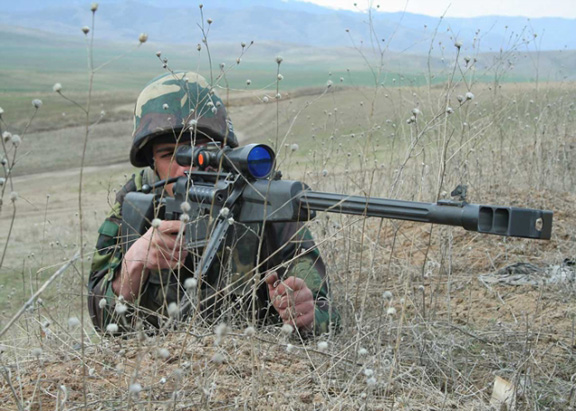
A Karabakh soldier at the border with Azerbaijan border
STAPANAKERT—Heavy fighting continued over the weekend along the border of Azerbaijan and the Nagorno-Karabakh Republic, with Artsakh’s Defense Ministry announcing Monday that 10 Azerbaijani soldiers were killed in sporadic fighting.
The Artsakh Defense Ministry also said that statements made by it Azerbaijani counterpart that seven Karabakh soldiers were killed were false adding that the Artsakh Army had repelled Azerbaijani attacks in the Akna region, which resulted in 10 dead and several wounded Azerbaijani soldiers.
This followed a week of heavy artillery attacks by Azerbaijani forces against targets in both Artsakh and Armenia, which left three civilians—majority of them elderly women—dead in Armenia’s Tavush region and four Karabakh soldiers dead along what is commonly known as the “line of contact.”
The Artsakh Army also reported Friday that 15 people were injured as a result of the Azerbaijani attacks that left four servicemen dead.
Armenian authorities vowed retaliation, with President Sarkisian on Saturday criticizing the international community’s false parity toward Azerbaijan and the Armenian Defense Ministry ordering its units to deploy heavy artillery in response to Azerbaijani attacks.
This latest escalation of combat took place against the backdrop of talks in New York by Armenian and Azerbaijani foreign ministers with the co-chairmen of the OSCE Minsk Group, which is tasked with resolving the conflict peacefully.
After angry talks with Elmar Mammdyarov, Azerbaijan Foreign Minister, Armenia’s top envoy Edward Nalbandian stated that it would accept a Minsk-Group proposal to set up mechanism to investigate cease fire violations in the region.
“Armenia has agreed to discuss the details of the mechanism, and we urged Azerbaijan to do the same,” the co-chairmen said in n a joint statement on Friday’s talks in New York between the Armenian and Azerbaijani foreign ministers. The co-chairs were present at the talks.
After the talks, Mammadyarov gave no indications that Baku will stop effectively rejecting the idea. “The creation of a mechanism for investigating armed incidents can be considered only if it does not serve to preserve the existing status quo … and does not justify [Armenian] occupation,” he told the official Azertag news agency.
Instead, Mammadyarov reiterated Baku’s calls for Armenians to “withdraw from occupied Azerbaijani territories,” referring to areas liberated by Artsakh Liberation forces during the war, and urged the co-chairmen to present a timetable for the “withdrawal.”
In Yerevan, Armenian Revolutionary Federation Parliamentary bloc secretary Aghvan Vardanyan noted that the OSCE Minsk Group co-chairing countries had the power to reduce tension on the Armenian-Azerbaijani border and prevent the killing of innocent civilians, if they so willed and proceeded to work together accordingly.
During discussions in the National Assembly on Sept. 25, Vardanyan further stated that the escalation of violence by Azerbaijan fit into an established pattern, in which ahead of every high-level meeting Azerbaijan resorts to increased violence.
“There are two ways of resolving this. One is to meet force with greater force, which I think our army is already doing to a degree. The second is—and I am deeply convinced of this—that if the OSCE Minsk Group co-chairing countries were willing and worked together, they could at the very least sharply reduce the tension and the instigation [of violence] by the enemy, as well as prevent the killing of innocent people. Ahead of every meeting regarding the peaceful resolution of the Nagorno-Karabakh conflict, Azerbaijan resorts to such [violent] actions, in which case our hopes rest in the strength of our army,” Vardanyan was quoted as saying by Yerkir Media.
Source: Asbarez
Link: 10 Azerbaijani Soldiers Killed, Says Artsakh Defense Ministry
